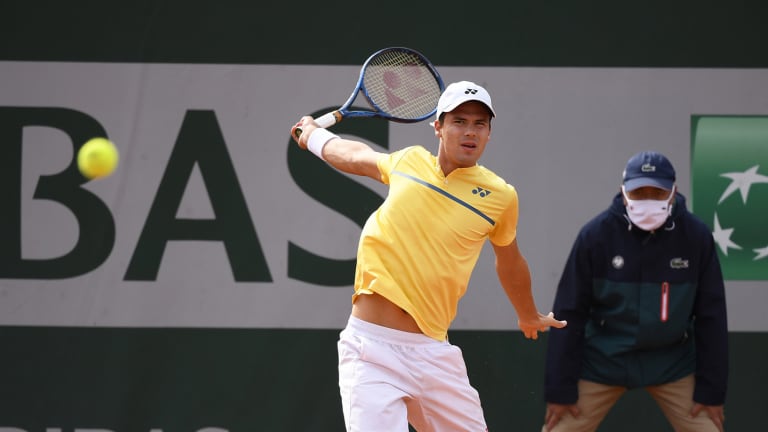Julien Crosnier / FFT
Today's stat sheet doesn’t lie: you had better numbers all around, from aces and winners to break point conversion success. Do you feel like everything you’ve gone through allowed you to step up in the biggest match you’ve played so far in your young career?
Today was about having high notes, mentally and physically—stroke wise. I didn’t really see the stats, but I could feel on court that I was a little bit above him all the time. It was a good feeling but still, I had to be there every point, because tennis can change so fast. I was really alert.
Even before qualifying, you had some confidence coming in with a pair of ATP Challenger semifinals. Is there anything you attribute to your time during quarantine that's now paying off with instant success these first couple of months?
It was definitely my physical condition. It is a special story. I was working almost every day with my physical coach in Argentina via Zoom. I had the phone and he was telling me, ‘Daniel this way, this time, this exercise.’ He was waking up sometimes at 5 a.m., was sleepy putting the camera on but it was great. We were able to have a block of 11 weeks with a focus on physical work and that helped me a lot. Tennis wise, I was not doing so much. I was maintaining my game I would say but at the same time, the physical work just gave me confidence to get out there and play, to be fit.
Walk me through the pair of injuries that eventually led to your ranking falling off completely in early 2019 (a nine-month layoff starting in 2018 and a nearly three-month stretch in 2017). Were these ongoing issues?
Everything started unfortunately with a tear in the Supraspinatus (shoulder), which happened when I played in 2017 in the Antalya quarterfinals. We saw with the doctor that something was wrong because I wasn’t able to lift the arm anymore. The shoulder was a little bit in front, which meant I had put a lot of pressure on the muscles.
After that, I was one percent recovered from the shoulder. But probably the mobility was not that good. We had to do more. Then I restarted to practice again, to play. Quite fast, I had unfortunately an accident on a hard court. I don’t know if you know from the tennis balls, there’s these yellow [fuzzy] things on the court that can become very slippery and with my left hip, I slipped and my pelvis moved.
At that time, I didn’t really have a team. I was using physiotherapists and doctors, but not with the tennis knowledge. I think this gives a little extra in understanding the right structure for tennis. I had a little bit of a structure problem in my body. This always forced muscle problems on my ab, on the back and the hip. That’s why I had to take off, be out of the tour for six or seven months, because I couldn’t play with constant abdominal problems. It was a very big risk to continue like this.
So you went back and played ITF Futures events. For a player with so much promise and who had previously "graduated" to the ATP Challenger level, how do you find the right mentality in having to start over from scratch?
The most important thing for me and I can suggest to young players playing Futures, is you have to get it into your head that there are no more easy matches. Every guy can play tennis, even in Futures. I was in Malibu one year ago playing a 25K. I watched the qualies and the college guys were so motivated because probably, they were playing to be on their team. Those guys always can have one or two days playing amazing.
Because I had quite a lot of success on this lower tour but having also some really tough battles, I think this made me a rough player, I would say. I saw the mentality of some guys. That was amazing for me to see coming again last year starting literally from zero. The game is developing a lot also. Everybody can beat anyone now.


